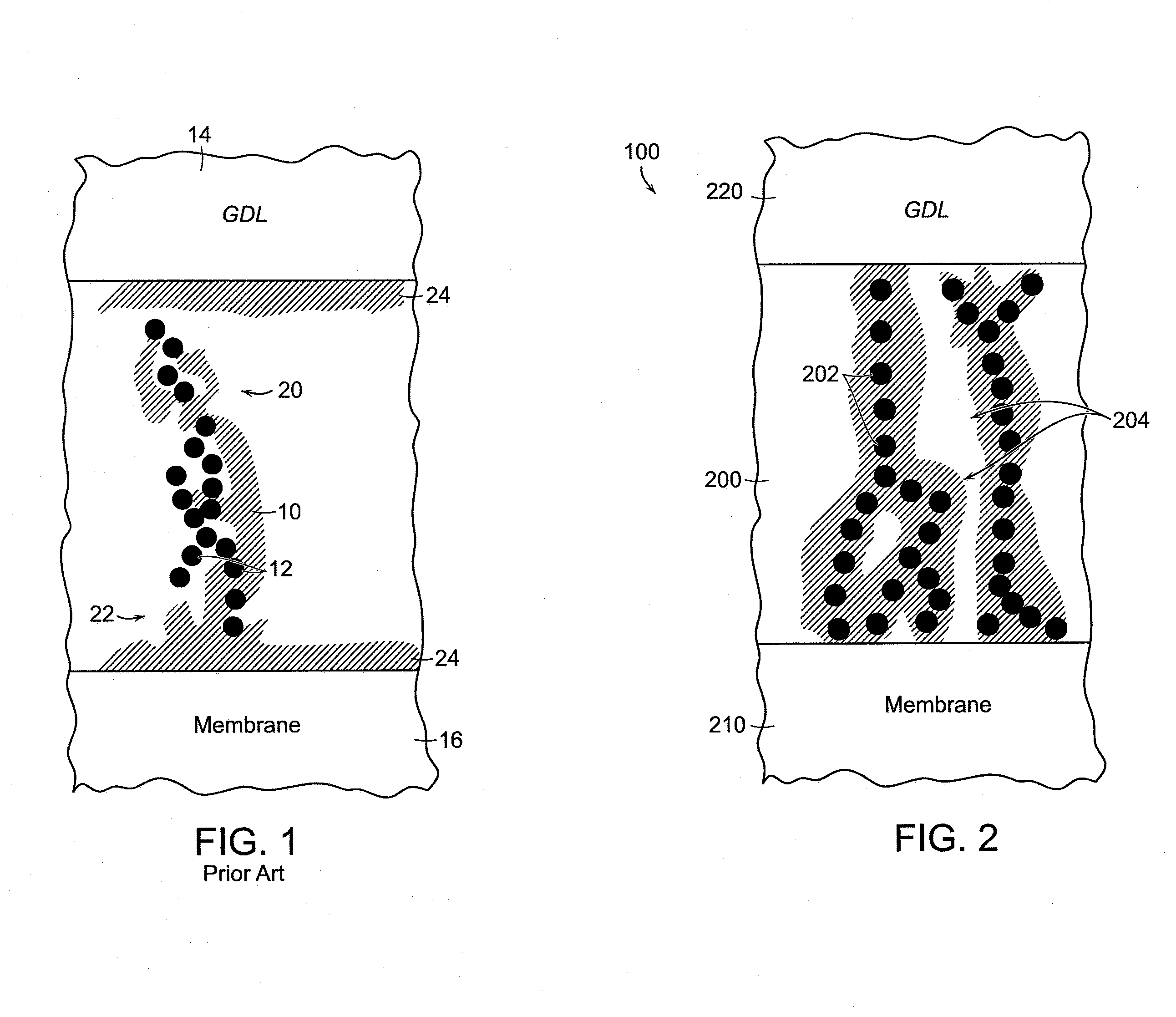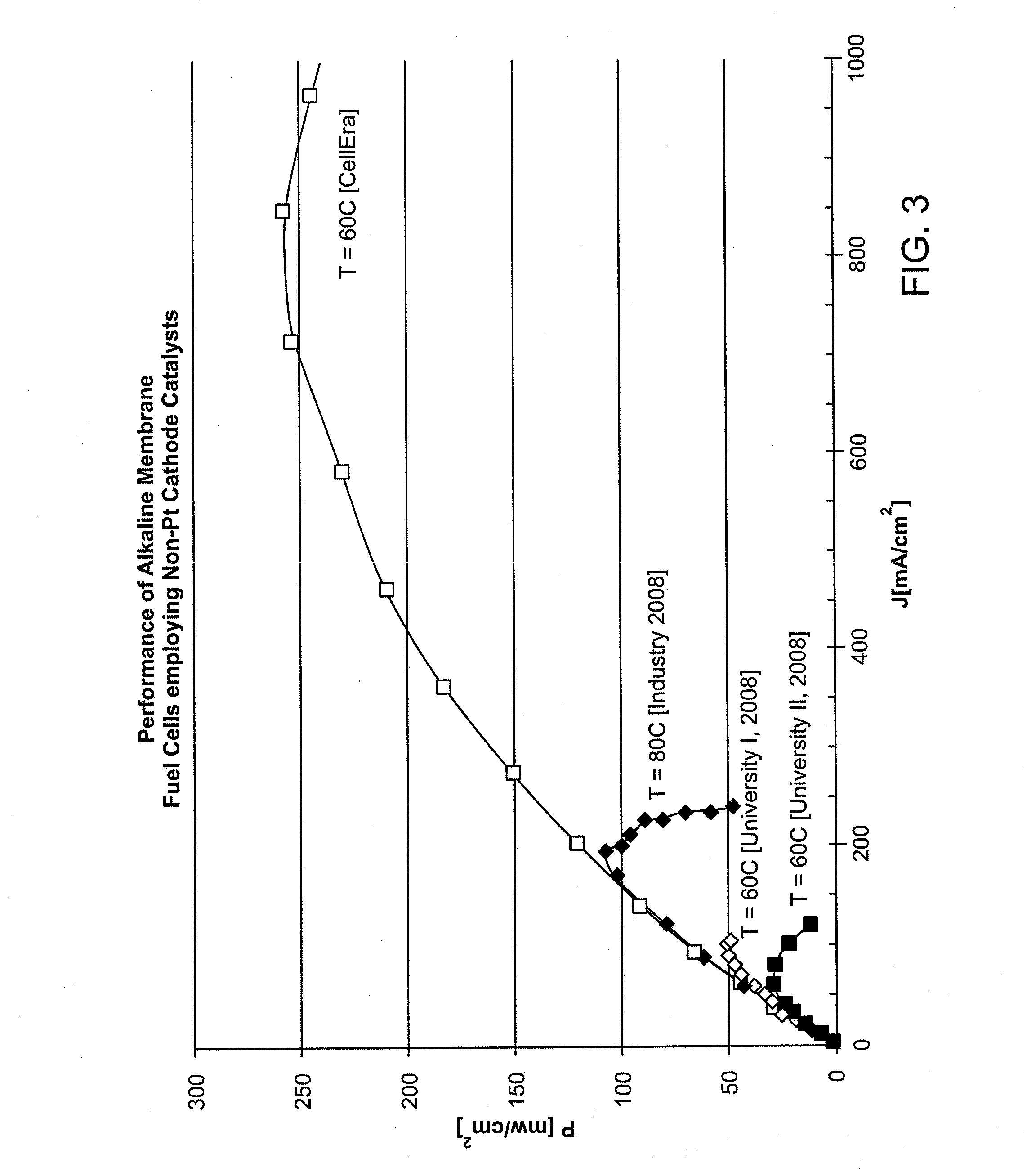Catalyst Coated Membrane (CCM) and Catalyst Film/Layer for Alkaline Membrane Fuel Cells and Methods of Making Same
a catalyst film and fuel cell technology, applied in the field of alkaline membrane fuel cells, can solve the problems of amfc posing a significant challenge, ion conductivity to the water level of an amfc operating amfc poses an additional challenge, and composition and fabrication challenges are more sever
- Summary
- Abstract
- Description
- Claims
- Application Information
AI Technical Summary
Benefits of technology
Problems solved by technology
Method used
Image
Examples
example i
[0051]An exemplary silver-based catalyst formulation or “ink” was prepared by mixing silver nano-particles 202 with a solution of quaternary ammonium-functionalized polymer (QAFP) in certain proportions to form a catalyst ink. In one specific embodiment, the silver nano-particles 202 are mixed with a solution of about 4% to about 5% QAFP in methanol or propanol. The silver nano-powder is added at ten times the weight of the QAFP. Water is added at about 30% of the volume of methanol, and ethylene glycol is added at the level of about 0.5% of the total ink volume. The catalyst ink is ultrasonicated for about 10 minutes, and then mixed, e.g., with a magnetic stirrer, for about one hour. The catalyst ink is ultrasonicated again for about 10 minutes, and then applied, e.g., sprayed or screen-printed, on at least a portion of the cathode side of the membrane 210, or on at least a portion of a Teflon® film blank, with the membrane or blank held down on a vacuum table heated at temperature...
example ii
[0052]Cells prepared by the process described in Example I had CCMs with a cathode Pt catalyst, requiring a volume ratio of ionomer:metal of 4:1 to secure high performance. These cells lost performance at an ever increasing rate under current demand of 0.3-0.4 A / cm2 ending up consistently with a steep drop of the cell voltage down to zero before the end of the second day of continuous operation. Other cells prepared according to Example I had a CCM with a cathode nano-silver catalyst, requiring a volume ratio of ionomer:metal of only 1:1.5 to secure high performance. These cells exhibited a significantly slower, constant rate of power loss at 0.3% the initial power output per hour.
[0053]The steep drop of the cell voltage down to zero was not seen in any of the cells with the nano-silver cathode catalyst over operation times of several hundred hours.
example iii
[0054]CCMs prepared according to Example I with nano silver cathode catalysts were prepared by air-spray application of the ink to a membrane placed on a heated vacuum table and exhibited a constant rate of power loss at about 0.3% of the initial power output per hour. Other CCMs were prepared in the same way and with a similar ink formulation, but using n-propanol as the only solvent (no water added) and applying the ink by screen printing to the membrane at room temperature. The screen-printed CCMs exhibited superior stability, losing only 0.1% of the initial power per hour over 300-400 hours.
PUM
| Property | Measurement | Unit |
|---|---|---|
| density | aaaaa | aaaaa |
| diameter | aaaaa | aaaaa |
| thickness | aaaaa | aaaaa |
Abstract
Description
Claims
Application Information
 Login to View More
Login to View More - R&D
- Intellectual Property
- Life Sciences
- Materials
- Tech Scout
- Unparalleled Data Quality
- Higher Quality Content
- 60% Fewer Hallucinations
Browse by: Latest US Patents, China's latest patents, Technical Efficacy Thesaurus, Application Domain, Technology Topic, Popular Technical Reports.
© 2025 PatSnap. All rights reserved.Legal|Privacy policy|Modern Slavery Act Transparency Statement|Sitemap|About US| Contact US: help@patsnap.com



